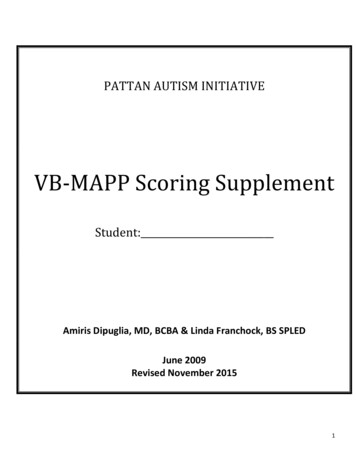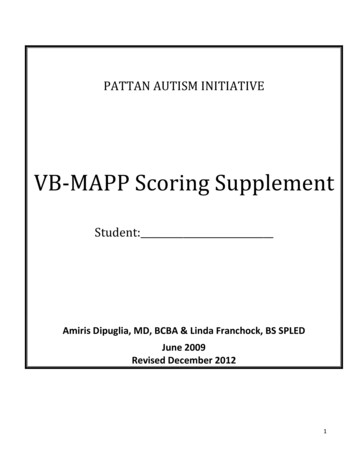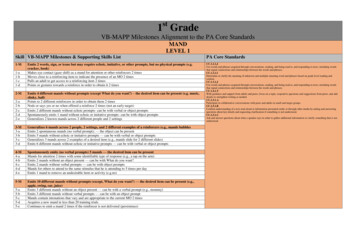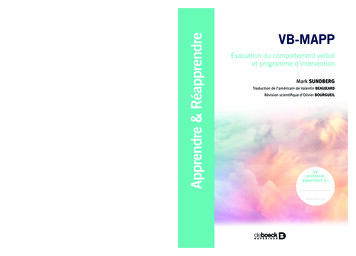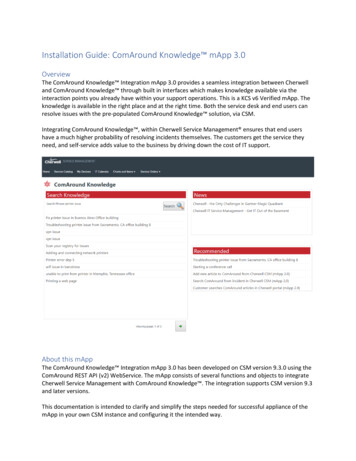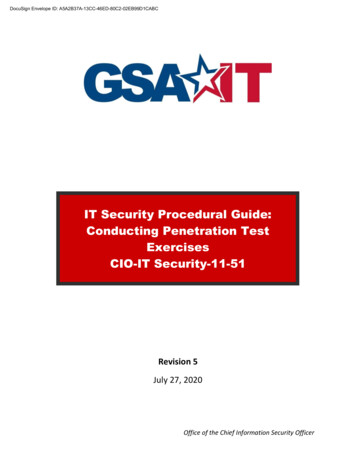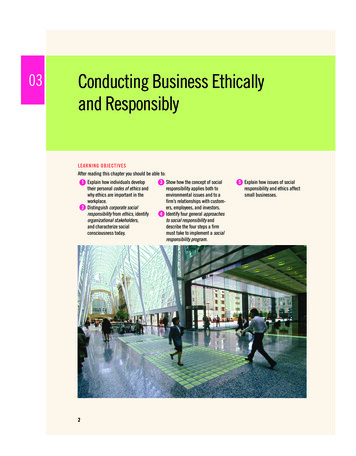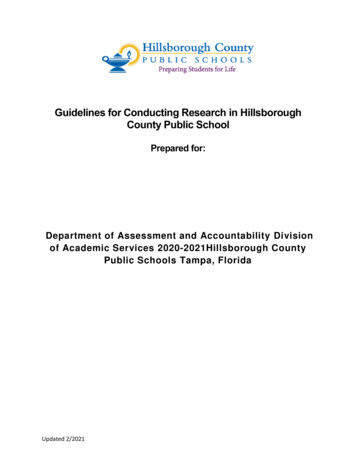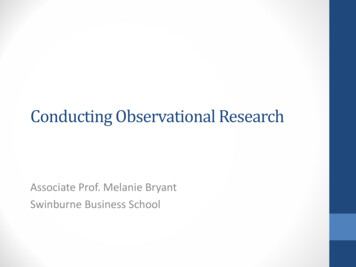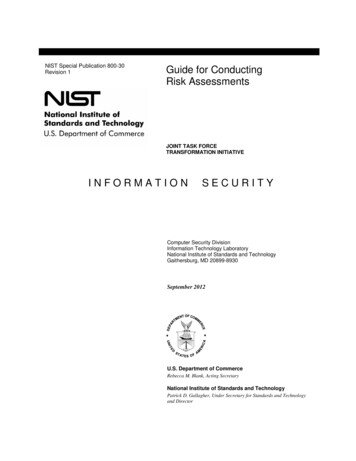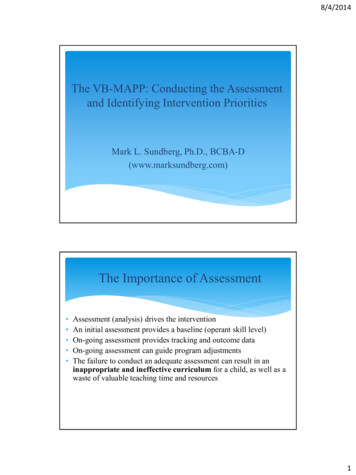
Transcription
8/4/2014The VB-MAPP: Conducting the Assessmentand Identifying Intervention PrioritiesMark L. Sundberg, Ph.D., BCBA-D(www.marksundberg.com)The Importance of Assessment Assessment (analysis) drives the interventionAn initial assessment provides a baseline (operant skill level)On-going assessment provides tracking and outcome dataOn-going assessment can guide program adjustmentsThe failure to conduct an adequate assessment can result in aninappropriate and ineffective curriculum for a child, as well as awaste of valuable teaching time and resources1
8/4/2014What Should be Assessed forChildren with Autism? It is essential to identify a child’s existing verbal, nonverbal, andsocial skills (e.g., mands, echoics, listener skills, peer initiation) It is also essential to identify the language, social, behavioral, andlearning barriers that are preventing or slowing down skill acquisition Most common language assessment tools for children with autism failto provide this necessary information (Esch, LaLonde, & Esch, 2010) For example, 28 out of 30 assessments fail to assess a child’s mandrepertoire (Esch et al, 2010), and none provide an assessment ofpossible barriersThe Value of a Criterion-ReferencedAssessment Norm-referenced vs. criterion-referenced A norm-referenced tests ranks and sorts students using percentilemeasures relative to a large sample of peers (e.g., IQ tests, SAT,PPVT, “Bell curve”) A criterion-referenced test provides a measure of a student’s masteryof a pre-determined group of skills (e.g., math skills) A criterion-referenced test provides specific information as to what astudent (or professional) can or cannot do in a certain domain (e.g.,manding, national board medical exam, BACB exam) A criterion-referenced assessment provides the operant level(baseline) of a domain of skills for an individual learner, and candirectly point to intervention needs and priorities2
8/4/2014A Behavioral Approach to Assessment forChildren with Autism Basic behavioral concepts and principles allow professionals toidentify and quantify learning, as well as barriers (e.g.,motivation, reinforcement, stimulus control, generalization) A behavioral analysis of typical human development provides aframe of reference for an assessment (e.g., Bijou & Baer, 1965;Schlinger, 1996; Novak & Pelaez, 2003; Skinner, 1957) Skinner’s (1957) analysis of verbal behavior provides abehavioral framework of language and social behavior that canbe used to guide an intervention program (Sundberg & Michael,2001)The Value ofSkinner’s Analysis of Language Expands and clearly delineates the traditional categories ofexpressive and receptive language “Expressive language” is expanded across the verbal operants echoic (motor imitation, tive “Receptive language” is expanded to four distinct repertoires listener discriminations (receptive language)audience participationmediator of reinforcementemotional responder3
8/4/2014Verbal Behavior Milestones Assessmentand Placement Program:The VB-MAPP There are five components of the VB-MAPP The VB-MAPP: Milestones Assessment measures 16 domainswith 170 language, learning, and social milestones, across 3developmental levels (0-18 months, 18-30 months, 30-48 months) The VB MAPP: Barriers Assessment examines 24 commonlearning and language barriers often faced by children with autism The VB MAPP: Transition Assessment is a summary assessmentof 18 domains and can serve as a guide for planning a child’seducational needsVerbal Behavior Milestones Assessmentand Placement Program:The VB-MAPP The VB-MAPP: Supporting Skills and Task Analysis provides achecklist of hundreds of additional skills that may not warrantmilestone status, but support the development of each of thedomains (e.g., mands for attention, tacts of auditory stimuli) In addition, this section contains a task analysis of the 170milestones, which is valuable for those progressing at a slower rate The VB-MAPP: Placement and IEP Goals providesrecommendations for program development based on the child’sVB-MAPP profile, and his specific scores on the 170 milestonesand the 24 Barriers Also contains a bank of over 200 IEP objectives directly linked tothe milestones and barriers assessments4
8/4/2014The VB-MAPP Milestones:How to Score the Assessment 16 domains are presented in three developmental levels:The elementary verbal operants (e.g., echoic, mand, tact, intraverbal)The listener skillsVocal outputIndependent playSocial skills and social playVisual perceptual skills and matching-to-sampleGrammatical and syntactical skillsGroup and classroom skillsBeginning academic skills30-48 monthsTypicaldevelopmentThere are 3developmentallevels18-30 monthsTypicaldevelopment0-18 monthsTypicaldevelopment5
8/4/2014Level 3 measures13 domains with65 milestonesFirst 6domainsappear inall threelevelsLevel 2 measures12 domains with60 milestonesLevel 1 measures9 domains with 45milestonesReading,writing, andmath areadded inlevel 3LRFFC, IV, group,and linguisticmeasures areadded in levels2 and 3Motor imitationand echoic appearonly in levels 1 and 2Vocal play (babbling)is dropped in levels 2and 36
8/4/2014Sophie A.7/1/113 yrs.7/23/14MSEnter tester(s)Enter thechild’s personalinformationEnterdateEntercolorHow to score the cells:Mand Level 11Enter a score of1, ½, or 0, basedon the scoring criteriain the VB-MAPP Guide5 Milestonesfor eachDomain, ateach level7
8/4/2014Designedfor 4 testingperiods, butmore canbe added4 ways to obtain therelevant data41/2Enter the totalscore here11111/2Add any relevant information such asspecific words, or oddities such as all 10mands are for different toy dinosaursThe scoring instructions and criteria arecontained in the VB-MAPP Guide5 items for eachmilestone8
8/4/2014VB-MAPPMaster Scoring FormKey:Child's name:WilliamDate of birth:Age at testing:1st test:4/12/1112nd test:234ScoreDate17/23/14ColorTesterMS3rd test:4th test:LEVEL .EchoicVocalMathEnter thetotal scorehere1514131211LEVEL 2Imitation109876LEVEL 1Imitation54Fill in thecorrespondingcells with thescores obtained321Copyright 2008 Mark L. SundbergVB-MAPPMaster Scoring FormKey:Child's name:WilliamDate of birth:Age at testing:Score1st test:4/12/111DateColor7/23/14TesterMS2nd test:2343rd test:4th test:LEVEL FCIVGroupLing.Math15141312Skills can betested one ata time, or alltogether11LEVEL FFCIVGroupLing.Repeat thetrial ifnecessary10987There is notime limit6LEVEL rrectresponsesCopyright 2008 Mark L. Sundberg9
8/4/2014VB-MAPPMaster Scoring FormKey:Child's name:Isander1st test:Date of birth:11/09/20062nd test:Age at testing:1 2-11234ScoreDate2710/28/09ColorTesterJ. Simmons3rd test:4th test:LEVEL icLRFFCIVGroupLing.Math1514131211LEVEL 2Fill in theoval for adomain thatwas tested,but a “0”score wasgivenImitation1091/2 point scores looklike this876LEVEL calSome milestonesmight get “0”while highermilestones aremet54321Copyright 2007-2008 Mark L. SundbergVB-MAPPMaster Scoring FormKey:Child's name:Isander1st test:Date of birth:11/09/20062nd test:Age at testing:1 2-11234ScoreDate2710/28/09ColorTesterJ. Simmons3rd test:4th test:LEVEL 33 things tolook for in EL 2Imitation109(3) Are there strongerskills that can be usedto teach weaker skills?876LEVEL 1(2) Are theskills fairly inbalance witheach oicVocal543(1) Primarylevel21Copyright 2007-2008 Mark L. Sundberg10
8/4/2014There are 5levels and 100possible pointsThe sounds aredevelopmentallysequencedThe first three levelsdiffer by the numberof syllablesThe last two involveprosody and othermeasuresScore theresponse asX, /, or blankEnter thescores here11/2XEnter the totalscore here/11
8/4/2014Convert thescores on thecorrespondingmilestone form1/2Enter thetotal scorehere1/20The specificinstructionsare in the VBMAPP Guide00011/2Enter the raw scorehere, as well as anycommentsVB-MAPPMaster Scoring FormKey:Child's name:WilliamDate of birth:Age at testing:Score1st test:4/12/111DateColor7/23/14TesterMS2nd test:2343rd test:4th test:LEVEL .EchoicVocalMath1514131211LEVEL 2Imitation109876LEVEL 1Imitation5432Fill in the cell1Copyright 2008 Mark L. Sundberg12
8/4/2014The VB-MAPP Barriers Assessment It is important to find out what a child can do (The VB-MAPPMilestones Assessment), but also important to be aware of theproblems and challenges he or she faces The VB-MAPP Barriers Assessment is designed to identify and score24 different learning and language acquisition barriers Many of these barriers are identified in the DSM-5 (inflexibleroutines, repetitive behaviors, deficits in social communication,sensory defensiveness, fixated interests) Once a specific barrier has been identified, a more detaileddescriptive and/or functional analysis of that problem is required An individualized functional or descriptive analysis will benecessary to determine the nature of the problem, and whatintervention program might be appropriate for the childThe VB-MAPP Barriers Assessment There are several different types of barriers that can affect learningand language development Strong and persistent negative behaviors that impede teaching andlearning (e.g., non-compliance, tantrums, aggression, SIB) Verbal operants or related skills that are absent, weak, or in someway impaired (e.g., echolalia, rote intraverbals, “mands” that arereally tacts) Social behavior and the speaker-listener dyad can also becomeimpaired for a variety of reasons (e.g., limited motivation for socialinteraction, impaired mands, impaired listener skills)13
8/4/2014The VB-MAPP Barriers Assessment Fundamental barriers to learning that must be analyzed andameliorated (e.g., the failure to generalize, weak motivators, promptdependency) Specific behaviors that can compete with teaching (e.g., selfstimulation, hyperactive behavior, or sensory defensiveness) Problems related to physical, medical, or biological barriers thatmust be accounted for in some way (e.g., articulation or motorimitation errors may be due to physical limitations, matching errorsmay be due to visual limitations, listener errors may be related tohearing problems, poor performance may be due to illness, sleepdeprivation, severe allergies, medication changes, pain, etc.)The VB-MAPP Barriers Assessment 24 Common Learning and Language Acquisition Barriers Behavior problemsInstructional control (escape/avoidance)Impaired mandImpaired tactImpaired motor imitationImpaired echoic (e.g., echolalia)Impaired matching-to-sampleImpaired listener repertoires (e.g., LD, LRFFC)14
8/4/2014The VB-MAPP Barriers Assessment Common Learning and Language Acquisition Barriers Impaired intraverbalImpaired social skillsPrompt dependency, long latenciesScrolling responsesImpaired scanning skillsFailure to make conditional discriminations (CDs)Failure to generalizeWeak or atypical MOsThe VB-MAPP Barriers Assessment Common Learning and Language Acquisition Barriers Response requirements weakens the MOReinforcer dependentSelf-stimulationArticulation problemsObsessive-compulsive behaviorHyperactivityFailure to make eye contactSensory defensiveness15
8/4/2014Enter the child’spersonal andotherinformation here.Sophie A7/1/113 yrs7/23/14MSEnter a scoreusing a 1-4 likertscaleLeave thebarrier blank fora score of “0”(no barrier)General criteria forscoring each of the24 Barriers can befound on pages 25-29in the Protocol3More detailedinstructionscan be foundin the VBMAPP Guide,Chapter 6Enter thescore here16
8/4/2014.Sophie A7/1/113 yrsMS7/23/14Enter the scorein the barriersformVB-MAPPLanguage Barriers Scoring FormKey:ScoreChild's name:Jacob1st test:26Date of birth:1/8/20092nd test:Age at testing:13234DateColorTesterMS3rd test:4th test:BehaviorProblemsImpairedMandInstructional ControlImpairedTactImpairedEchoicEnter thetotal enerImpaired VP-MTS1234Impaired Intraverbal12341Impaired SocialSkills2341PromptDependent234Scrolling4Many of the barrierscan be detectedwhile conducting themilestonesassessment (e.g.,non-compliance,scrolling)3211234Impaired Scanning1234Impaired ConditionalDiscrimination123412341Failure to Generalize234ResponseRequirementWeakens MOWeakMotivators1234Reinforcer Dependent432112Self-34Stimulation1234Impaired Articulation1234ObsessiveCompulsive Behavior1234Hyperactive Behavior1234Failure to MakeEye Contact1234Sensory Defensiveness432112341234123412341234123417
8/4/2014VB-MAPPMaster Scoring FormKey:Child's name:Derek1st test:Date of birth:ScoreDateColorTester37AM2nd test:1Age at testing:4. 6243rd test:4th test:LEVEL .EchoicVocalMath1514131211LEVEL 2Imitation109876LEVEL 1Imitation54321Copyright 2007-2008 Mark L. SundbergVB-MAPPLanguage Barriers Scoring FormKey:ScoreDateChild's name:Derek1st test:297/3/07Date of birth:1-23-032nd test:1Age at testing:4.6234ColorTesterSM3rd test:4th test:BehaviorProblemsImpairedMandInstructional 432112341234Im
VB-MAPP profile, and his specific scores on the 170 milestones and the 24 Barriers Also contains a bank of over 200 IEP objectives directly linked to the milestones and barriers assessments Verbal Behavior Milestones Assessment and Placement Program: The VB-MAPP . 8/4/2014 5 16 domains are presented in three developmental levels: The elementary verbal operants (e.g., echoic, mand .
